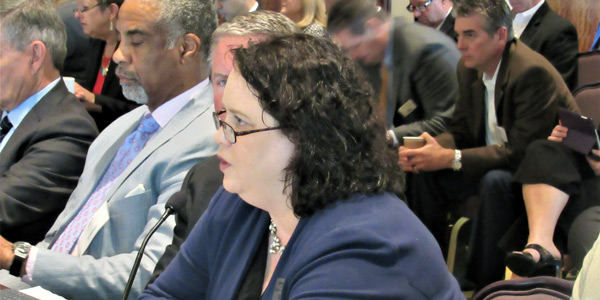By Amanda Durish Cook
CARMEL, Ind. — MISO is proposing to eliminate a footprint-wide postage stamp rate and change its rules for market efficiency projects to include regional cost allocation for transmission projects under 345 kV.
The RTO wants to lower its cost allocation threshold to cover 230-kV projects, a move that Director of Strategy Jesse Moser said will capture a reality in the footprint, where 230-kV lines are prevalent and transport a high volume of electricity.
Speaking at a Feb. 13 Organization of MISO States (OMS) board meeting, Moser pointed out that certain parts of the RTO operate at a maximum 230-kV rating, especially in MISO South. That voltage represents a “sweet spot for effective mitigation of congestion,” according to MISO.
“This puts essentially the whole footprint on an equal playing field in terms of getting a cost-shared project approved,” Moser said.
Postage Stamp Removal
MISO is also recommending that it scrap its footprint-wide postage stamp rate for market efficiency projects. The RTO currently allocates 80% of project costs to local resource zones based on expected benefits and recovers the other 20% via postage stamp allocation to all regional load. Instead, MISO wants to assign all costs to benefiting transmission pricing zones and work with stakeholders to create more specific benefit metrics. The move will make for “more granular, more targeted cost allocation,” Moser said.
MISO currently relies on the postage stamp rate as a means of recognizing both transmission benefits not currently quantified within its cost allocation and the changing nature of beneficiaries as the fleet evolves.
Currently, there is no regional cost allocation within MISO for transmission projects below 345 kV, and Minnesota Public Utilities Commission staff member Hwikwon Ham said if it were to abolish its postage stamp rate, it should detail a much more precise set of valued benefits.
In adding new benefit metrics for cost allocation, Moser said MISO may consider aspects such as deferred reliability projects and savings that could arise from opening up the contract flow path with SPP that bridges MISO South and Midwest.
“The benefit metrics discussion will continue,” Moser promised state regulators.
Wind on the Wires’ Natalie McIntire asked MISO to devise a benefit metric for projects that facilitate state renewable portfolio standards.
The RTO will also consider creating smaller transmission cost allocation zones for a more targeted cost allocation and will hold discussions with stakeholders, Moser said.
However, MISO will leave some market efficiency project requirements untouched, including the benefit-based allocation to all zones, a required benefit-to-cost ratio of at least 1.25:1 and the $5 million minimum project cost threshold.
The proposed changes would not apply to multi-value projects. Moser said stakeholders offered “a lukewarm response” to any possible changes to those projects.
MISO is seeking to draft a nearly final allocation proposal by June, with a FERC filing to follow in September or October. It hopes to get approval by the end of the year and introduce the new allocation in early 2019.
Entergy’s integration transition period, which limits cost sharing in MISO South, expires at the end of this year. The RTO has not revised its cost allocation rules since the integration of South in 2013.
‘Something You All Can Live With’
“We’re certainly zeroing in on some specific reforms,” Moser told stakeholders at a Feb. 15 Regional Expansion Criteria and Benefits Working Group (RECBWG) meeting. “We really tried to find areas where we could get broad support. We hope the overall package is something you all can live with.”
Xcel Energy’s Carolyn Wetterlin, chair of the RECBWG, reminded stakeholders that no allocation proposal will satisfy every stakeholder’s wish list.
“We’re getting into that phase where we really have to think about what we’re solid on and where we could give a little as we move toward a filing,” Wetterlin said.
Some stakeholders at the meeting asked for MISO to consider lowering the threshold further to 100 kV, given that some 100-kV projects are needed for reliability and provide economic benefits. Others pointed out that two years ago, FERC ordered a 100-kV minimum threshold for interregional market efficiency projects with PJM. But MISO has yet to propose a regional cost allocation for interregional economic projects down to 100 kV on the PJM seam.
MISO itself originally considered a 100-kV cost allocation threshold for market efficiency projects in a draft proposal issued last year.
Moser said 100-kV lines with solid business cases will still be eligible for local cost allocation, but the RTO prefers that costs for such low-voltage projects are not shared footprint-wide.
“We looked at all the perspectives we heard over the last year, and we view the 230-kV threshold as a reasonable compromise,” Moser added.
Since Entergy’s integration into MISO, the RTO has approved two 230-kV projects in MISO South that qualified under the “economic other” category, which are only eligible for recovery in zonal rates.
Other stakeholders argued for MISO keeping the 345-kV status quo, with one stakeholder saying lower voltage “Band-Aid projects” with limited footprint-wide benefits should not be allocated like higher-voltage “backbone” projects.
Last September, MISO Vice President of System Planning Jennifer Curran told the Board of Directors that the RTO anticipated a range of opinions among stakeholders on cost allocation approaches.
“It’s not surprising that we’ve heard a very large number of opinions,” Curran said at the time. “The one thing that holds true is that when MISO recommends transmission, we have to have a good, strong business case. We can’t recommend things that we don’t think will get passed.”
MISO will continue the cost allocation discussion with stakeholders at the March 15 RECBWG meeting.






